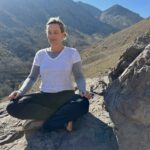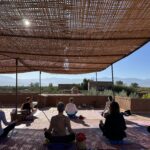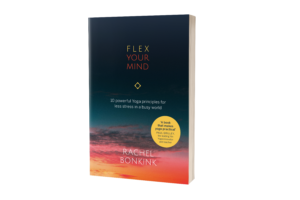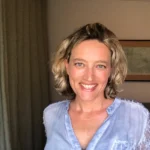‘Just breathe, just follow your breath, allow the body to breathe‘, you’ve probably heard these words before at some point in a yoga or meditation class. Resulting in a sweet roll of the eyes perhaps.
An understandable roll of the eyes as it can be seriously boring to observe your breath.
I mean; seen one breath, seen them all, right?
At the same time, there is this fact that not one breath is actually the same as the other. Every single inbreath and outbreath is wonderfully unique.
So why is it that so many mindfulness practises start with observing the breath?
1. Body-Mind Connection
The breath happens IN the body. This means there is a connection between body and mind when you start observing the breath.
By attending to the way that you breathe, you are creating a sense of union. And ‘union’ is not by accident one of the Sanskrit translations of the word Yoga.
When we’re knocked off balance by something, we have often lost this connection. In a very gentle and soft way, observing the breath can be the first step in (re)-establishing your connection between body and mind.
2. Surrender
When we allow the breath to flow through us, we have to surrender to the process. We need to let go of control.
There is this urge to control the breath as soon as we start focussing on the breath. Maybe not just controlling the breath if you take this out of context – we tend to want to control whatever it is that gets our attention, but that’s whole different topic in itself.
Observing the breath can be so beneficial as we need to learn to trust our own body and surrender to the process of breathing. Surrender to what is, one of the 10 principles of the Yoga philosophy. The body is quite capable of breathing on its own, as you know, we all breathe when we sleep….
If you want to read more about the principles of Yoga philosophy, I suggest checking out my book on how to Flex Your Mind.
3. Meditation or concentration?
What most people refer to as meditation is actually concentration. And concentrating on the breath as a technique is super convenient as there’s no need for any props or extra material. You don’t need anything special, the breath is always there.
When we want to learn how to meditate, we need to learn how to concentrate first. We need to train our attention skills and develop a base layer of peace of mind. Once we have this foundation, we can explore the mind a bit further and gather more ‘insight’ in the mind.
4. Proper breathing rejuvenates
You can not learn how to meditate if you don’t know how to observe your breath and work with the breath.
On all my yoga and meditation retreats, there is an element of pranayama (working with the breath) in every single class. All meditation challenges will have a section of breathing exercises.
Breathing rejuvenates and recharges us: this is not something I believe in but it’s a proven fact. The opposite is also true, a shallow breathing will make you tired in the end. This is not exactly new as breath management was indicated as a crucial step on the Yogic path about 200 BCE already.
Just take 3 nice long breaths and sigh it out. Right here and right now. It instantly relaxes.
5. Keep It Simple
The basics of the Anapanasati technique, which literally means mindfulness of breathing in Sanskrit, are fairly simple and easy to learn. In several steps you explore your own breathing patterns and zoom in on several aspects of the breathing process. This technique initiates an awareness about the depth and the length of each breath for example. It makes you aware of the interval in between breaths where nothing seems to happen.
At the same time, the thinking mind will come up with all kinds of glorious observations and will lure the meditator into discussions about whether the breathe is long or rather short. With the breath as the overall focus point, the instruction to bring the attention back to the breath whenever one wanders off too far is easy to follow and understand.
If you’re interested in starting or restarting with meditation, check out the Meditation Challenges on www.rachelbonkink.com .
All meditations are guided and live, so you will have your teacher right there with you, and you will see other meditators there as well. The power of meditating live, together, is incredible.
Rachel Bonkink
I’m a meditation and yoga teacher, a published author, accomplished speaker and founder of Revealing Vajra-amazing yoga retreats. In a past life, I fully enjoyed the corporate life as an operational director of medical market research firm.
Grateful to have followed many in person trainings (over 1000 hours) with Paul Grilley, Sarah Powers, Bernie Clarke and Alan Wallace. My favourite thing to do is to make meditation easy and guide people into creating more peace of mind.
Will you join me on the next Meditation Challenge?








Leave a comment